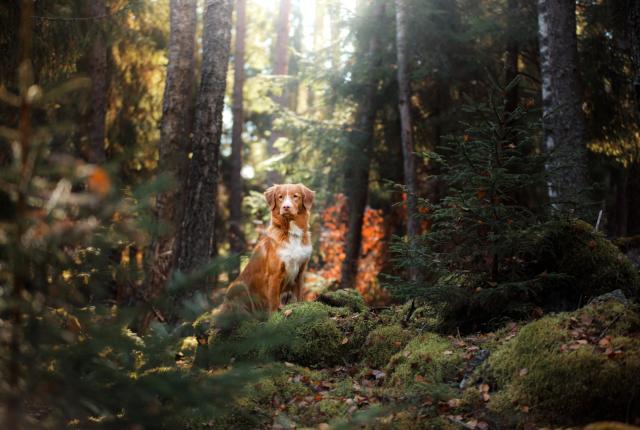How do you enjoy summer with your dog? Perhaps you like to take walks in nature together or go swimming? There are so many ways to spend fun summer days with your dog. However, some summer activities contain risks. We have put together a checklist of the most common risks for your dog this summer so you can spend the season together safely.
Summer heat involves a variety of direct and indirect risk factors. People’s summer foods can be harmful to dogs. Below, you will find the Finnish Kennel Club's checklist for a safe summer. The list has been compiled in cooperation with the Kennel Club's veterinarian Liisa Lilja-Maula.
Heatstroke
In the scorching summer months, heatstroke is a real risk for your dog. A heatstroke can happen in the backyard, in the car or while on a walk. Even indoors, it is important to be careful in hot weather and to ensure adequate ventilation. Fresh water should always be available, and your dog should be monitored.
Heat stroke is caused by a dog’s body temperature rising dangerously high. Symptoms of heat stroke include panting, apathy, restlessness, stumbling, drooling, bright red mucous membranes, vomiting, and diarrhoea. If your dog is in shock or unconscious, the situation is life-threatening.
If the dog has spent too much time in a warm place, the dog should be moved away from the heat as an immediate first aid. For example, you can cool your dog by watering its paws, belly and groin with cool, but never ice-cold water. Give your dog small amounts of water at a time and take the dog to the vet as soon as possible.
Short-nosed dogs, dogs with heart defects, puppies and older dogs are particularly susceptible to increased body temperature. Thin coated and hairless dogs also need to be protected from sunburn.
Never leave your dog alone in the car in hot weather. Even if the dog is in a shaded place in the car, the car is parked in the shade and the windows are open, the temperature inside the car can rise quickly. Leaving a dog in a hot car is an animal welfare crime. Heat stroke is not only a risk for a dog left in a car, but also for a dog left leashed in a sunny and warm location. When travelling in a car, try to avoid placing your dog in direct sunlight. Even in an air-conditioned car, it should be ensured that cool air also circulates into the dog's travel space, especially when the dog is travelling in the boot of the car or in a carrier. Also take breaks at reasonable intervals to allow the dog to go out and get some fresh air. Inside the car, cold trays or bottles of icy water wrapped in a towel can help ease the dog's discomfort.
Longer walks are best done in the morning before the temperature gets high or in the evening when the air starts to cool. It's a good idea to take a water bottle with you when you walk your dog in warm weather. It’s best to keep your outdoor activities as short as possible during the day. When outdoors in sunny weather, you should try to avoid walking long distances on asphalt. The temperature of asphalt can get very high in the sunshine, causing damage, even burns to the dog’s paws.
Swimming
Swimming in hot summer weather is a great way to cool down, both for dogs and people. However, check the water quality before letting your dog swim. Toxic blue algae can occur in sea and lake waters. Blue algae usually occur in water as greenish or yellowish particles. The algae may also appear as discolourations that have settled on the beach. If there is a lot of algae, it will form a creamy layer on the surface of the water. As the waters warm up, blue algae become more common.
If you see blue algae in the water, don't let your dog drink the water or swim in it. If your dog does get into the water, wash and rinse your dog’s coat thoroughly to prevent skin irritation. A dog that has been seriously exposed to blue algae usually has severe symptoms. Symptoms include vomiting, diarrhoea, muscle spasms, loss of coordination and severe tremors. Drinking water poisoned by blue algae can lead to death. If you suspect that your dog has been poisoned by blue algae, contact your veterinarian immediately.
Drinking salty seawater is also not good for your dog. Even clean seawater in large quantities can cause malaise and salt poisoning. When planning a swimming trip with your dog, please note that Finnish law prohibits dogs from being taken to public beaches. However, many municipalities have beaches for dogs.
Hot spots
A hot spot is a red and moist area of inflammation on your dog’s skin. Hot spots can be caused by any local irritation on the skin, but in the summer, especially in breeds with dense fur, prolonged dampness can predispose the development of hot spots. Keep an eye on your dog’s skin and make sure your dog’s coat gets dried after swimming or showering. The symptoms of a hot spot include local itching, irritation and pain. The dog may try to scratch or lick the inflamed area, causing the infection to spread. You can make your dog feel better by shaving the fur from the inflamed area, allowing the skin get some air and making it easier to clean and disinfect the area. If home care does not help, contact your veterinarian.
Ticks
The tick season is already in full swing. It’s a good idea to check your dog for ticks after every outdoor activity. Ticks can travel in your dog’s coat or can be found already attached to the dog’s skin. The best way to remove attached ticks is with a dedicated tool, such as tick tweezers or a tick remover. Removal is easiest by grasping the tick as close to the dog's skin as possible and twisting the tick slightly while pulling. After tick removal, it is good to disinfect the bite area.
Protecting your dog from ticks is important for the health of your dog and the rest of your family. Tick bites in dogs can cause diseases such as anaplasmosis and borreliosis, which are bacterial infectious diseases. It takes several hours for these to pass from the tick to the dog. Tick-borne encephalitis, which is less common in dogs, can be transmitted in just a few minutes. Unattached ticks can transfer from the dog’s coat to humans. For tick control, it is recommended to get tick prevention medicine from either your vet or pharmacist. There are many different tick products available, so it’s a good idea to consult an expert to find the right one for your dog. In any case, your dog should be checked for ticks every day.
Vipers and wasps
Dog owners should be particularly vigilant in areas where vipers are known to be abundant. A viper bite can be life-threatening for a dog. A viper most often bites the dog’s nose or paw when the dog sniffs the ground or examines the snake. If your dog is bitten by a viper, the dog and the bite site should be kept as still as possible to prevent the venom from spreading to other parts of the body. If possible, bitten dogs should be carried away from the site. However, if this is not possible, you should walk calmly when leaving. After a viper bite, the most important thing is to stay calm and take your dog to the vet right away. It is a good idea to inform your vet that you are coming in with a dog with a viper bite. Two adjacent puncture holes may appear at the bite point, but there is not always a trace. The most obvious symptom is severe swelling and pain in the bite area. The dog may also become weak or vomit. Dogs should not be given a snake bite tablet unless the swelling caused by the bite threatens to block their airways. The cortisone contained in snake bite tablets in combination with the viper's venom may increase the risk of kidney damage.
A wasp sting can also be dangerous for your dog. Often a wasp will sting a dog on the head or paws. This may cause an allergic reaction. If the symptoms are severe, such as rapidly increasing swelling, itching, vomiting, weakness or swelling of the airways, a veterinarian should be consulted immediately. In mild cases, oral snake bite tablets containing cortisone can also be used to treat wasp stings in dogs.
Dangerous summer treats for dogs
Summer is all about barbecuing. However, not all human treats, such as salty, spicy and fatty barbecued foods, are suitable for dogs. Corn cobs, ice-cream sticks, fish bones, fish cleaning waste and barbecue sticks are also dangerous as they can block or damage your dog's digestive tract. Small and sharp bones found in pork and chicken are also harmful to dogs. Other common foods that are dangerous for dogs include chocolate, xylitol and onion. Ice cream in large quantities can cause diarrhoea in dogs. Don't leave food unattended within reach of your dog.
Keep your dog leashed
The Hunting Act stipulates that wild animals must be allowed to breed in peace and dogs must be kept leashed or immediately leashable from 1 March to 19 August. This does not apply to dogs working for the police, Customs, Defence Forces or the Border Guard or dogs being trained for shepherding, guiding or guarding tasks. Puppies under five months of age and service dogs are also excluded. Dogs may only be allowed to roam free with the permission of the owner or occupier in a yard, garden or other fenced area. In conservation areas, dogs must be kept on a leash around the year.
Home pharmacy for dogs
When travelling and spending time at the summer house, it is a good idea to bring pharmacy products with you for first aid. For your dog, you should bring a few basic items such as nail clippers, wound disinfectant and bandages for paw sores, at-home diarrhoea treatment product, a thermometer, tick tweezers or a tick remover and snake bite tablets for wasp stings.
The Finnish Kennel Club wishes you all a safe summer and lovely summer days spent with your dog!




 Hau-Hau Champion
Hau-Hau Champion Agria
Agria